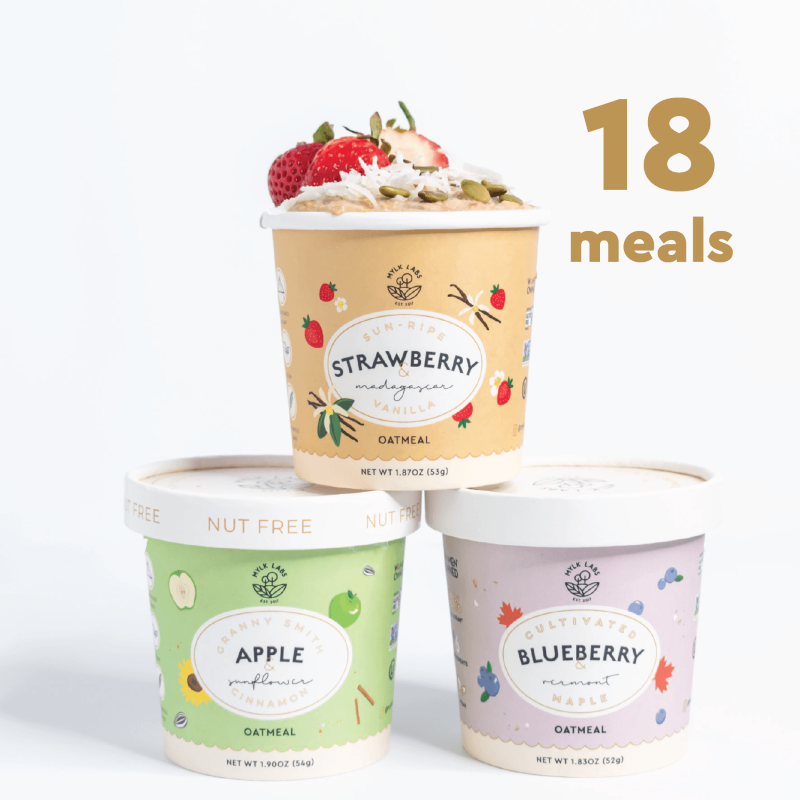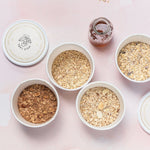These days, we’re all trying to eat healthier. Unfortunately, it’s hard to know what “healthy” really means.
Do you want low-fat or full-fat? Egg yolks or egg whites? And what’s the deal with gluten?
Gluten — it’s often thrown around as a buzzword, but it’s important to know what it means before cutting it out of your diet entirely.
Read on to learn all about gluten and how it impacts your piping hot bowl of delicious oatmeal.
What is Gluten, Anyway?
It’s hard to judge whether you should opt for a gluten-free diet if you don’t even know what “gluten” is. Let’s fix that.
Gluten is a general name for proteins found in grains like wheat, rye, barley, or triticale. These proteins are powerful and act like glue, keeping these foods in shape and intact as they’re processed.
So, gluten’s not exactly a bogeyman. But just like peanuts or shellfish, gluten does become an issue when it falls into the wrong stomach.
Is Gluten Unhealthy?
Terms like “unhealthy” and “healthy” are best determined by a medical professional as the answer depends on the individual.
Some people are born with celiacs disease, an autoimmune condition that causes those afflicted to become sick when they eat gluten. Even people without celiacs might have gluten sensitivity and experience symptoms like sluggishness, bloating, and abdominal pain when they eat too much gluten.
Pay attention to how you feel the next time you eat something with gluten like bread or pasta. If you feel fine, enjoy away! If you start to feel queasy or bloated afterward, you might have a gluten sensitivity.
Is Oatmeal Gluten-Free?

Despite being closely related to wheat and barley, oats are naturally gluten-free. This makes a hot bowl of oatmeal a great option for those who are sensitive to gluten. However, choose wisely as your bowl might contain more gluten than you think.
This is because many oats you’ll find in the grocery store are grown, processed, and packaged alongside gluten-heavy grains. Those proteins rub off and sneak their way into supposedly gluten-free batches of oats. This process is called cross-contact, and it’s something more oatmeal brands should look out for.
One study in 2008 found that 71% of commercial oat products failed to meet the FDA standards of earning a “gluten-free” label, meaning they could cause symptoms in people with celiac disease. Another study of Canadian commercial oats found cross-contact in 88% of the samples tested.
Luckily, there are two main ways that facilities can cut out cross-contact with gluten grains:
Purity Protocol
Purity Protocol is a method of growing and processing oats that promises that oats are isolated from gluten all the way from the field to your mouth. At Mylk Labs, we strive to keep our heart-healthy oats gluten-free and only buy Purity Protocol oats.
Unfortunately, the term itself isn’t regulated, and some oat vendors claim to operate under Purity Protocol while not fully living up to the standards they promise.
Hint: if Purity Protocol isn’t verified by an independent third party, it’s probably not that pure.
Mechanical Sorting
Mechanical sorting is a late-stage sorting process that can be effective in removing gluten-containing grains from delicious batches of oats. Using a combination of visual inspection and machine sorting, oats are categorized by size, shape, and color to remove mold and gluten particles from your breakfast bowl.
Most facilities limit how much gluten can be contained within a batch of oats but generally aren’t extra careful in their packaging unless verified by a third party.

Does My Oatmeal Have Gluten?
So, many products claim to be low in gluten but test at high enough levels to produce stomach problems in those with celiacs. This leaves those with any gluten sensitivity out in the cold when it comes to enjoying a piping-hot bowl of oatmeal.
Fortunately, there is a way to determine if your oats are truly gluten-free. Simply look at the package. The Celiac Disease Foundation recommends that people with gluten sensitivities only eat oats that have earned a dependable gluten-free label.
Oat products can earn gluten-free certification if they pass rigorous quality testing with an independent third party. These organizations test whether facilities process and manufacture their oats with attention to purity protocol and mechanical sorting, using even stricter thresholds than the FDA.
To earn an endorsement from the Gluten-Free Certification Organization, vendors must have every ingredient test at lower gluten levels than 10 parts per million (ppm). They also have to submit test results to the GFCO on a regular basis, ensuring true gluten-free eating.
In other words, if your oats aren’t from a certified gluten-free oatmeal brand, you’re rolling the dice. Instead, look for brands certified by the GFCO, like Mylk Labs.
Every cup of Mylk Labs’ gluten-free instant oatmeal is certified by the GFCO, meaning each bite is safe to eat for those with celiacs and gluten sensitivities.
Not only is our oatmeal gluten-free, but it’s also herbicide-free. Our oat vendor is certified by The Detox Project as glyphosate-free, meaning each bite is uncontaminated by the world’s most common herbicide.

Try Certified Gluten-Free Oatmeal
As you can tell, we care about our oats. We believe that busy breakfast eaters have a right to know what they’re putting in their bodies.
That’s why we’re gluten and glyphosate-free. It’s also why we created a low-sugar, low-sodium, delicious instant oatmeal made up of simple, heart-healthy ingredients.
So, eat up! Mylk Labs’ instant oatmeal is a no-brainer for those in the gluten-free community and for anyone who cares about delicious, guilt-free eating.























